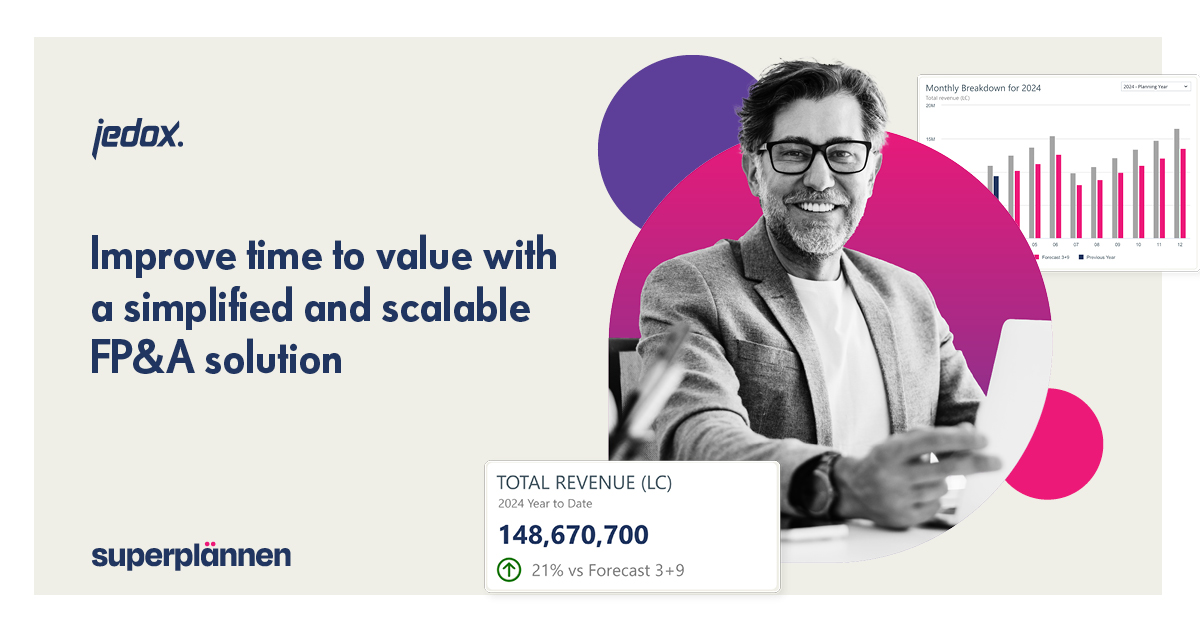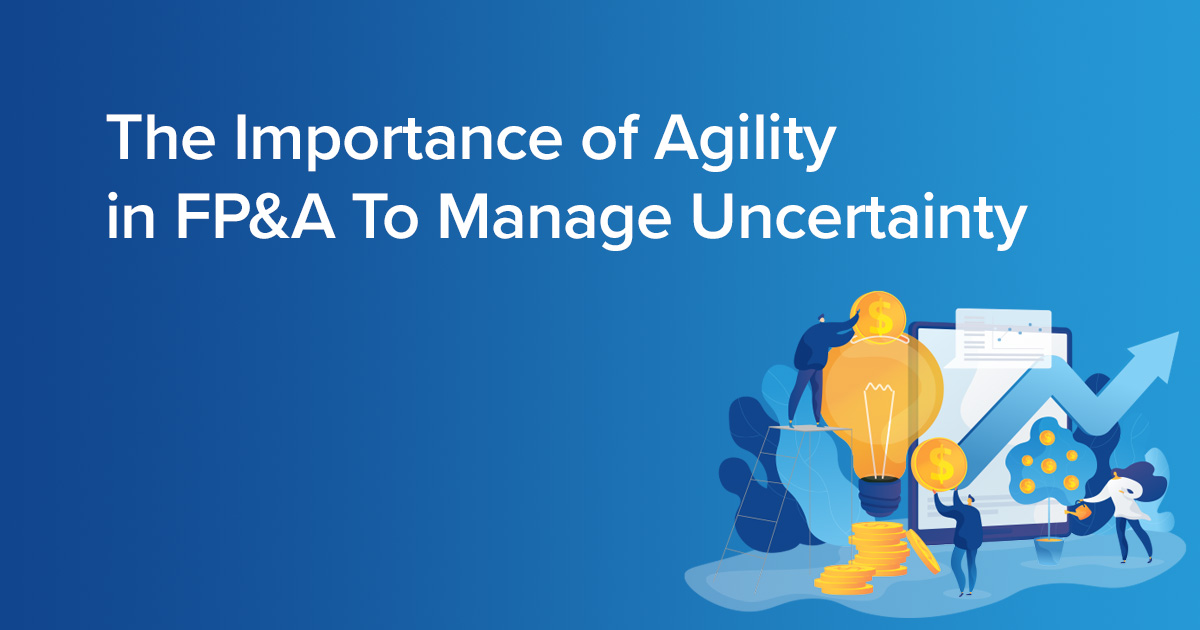
Your guide to the corporate financial planning process
- What is the corporate financial planning process?
- What is the goal of corporate financial planning?
- Why are financial planning and a financial plan important?
- Five benefits of financial planning
- The different types of corporate financial planning
- Steps in the financial planning process
- Avoid these mistakes in your corporate financial planning process
- Five challenges in corporate financial planning
- Traditional vs integrated financial planning
- AI in financial planning
- The way forward
How can we ensure our company maintains sufficient liquidity to meet both short-term obligations and long-term growth opportunities? What financial risks are we exposed to, and how can we mitigate them effectively? Is there a way to determine the future economic situation of our business? The answer to these questions and more are found in establishing solid corporate financial planning.
Early 2020 saw people around the world begin to stockpile necessities. An unprecedented crisis had begun, and global uncertainty mounted by the minute. As a result, many hoarded items such as toilet paper, dry pasta, and other commodities as a safeguard for an uncertain future.
For companies, money is that safeguard. Businesses should always be solvent and have enough cash to pay outstanding bills, make investments when there is a surplus, and reduce expenses when it slips into the red. But how do you know if your business is always solvent? To stay on top of your income and expenses, you need a solid corporate financial plan and related financial KPIs. Learn how to create one in our guide to the corporate financial planning process.
In this post, we’ll look at what you should consider in the corporate financial planning process, what pitfalls to avoid, and how to outperform the competition.
What is the corporate financial planning process?
A financial plan is the section of your business plan that outlines how your company will handle its finances. The purpose of the financial plan is to make sure you have the resources to meet your business goals while managing risks and seizing opportunities.
The financial plan maps out your company’s financial future and ensures every decision you make is grounded in solid data. By tracking and analyzing all your financial information, you see exactly how efficiently your business is operating.
What is the goal of corporate financial planning?
The goal of corporate financial planning is to use the available resources—primarily financial resources—as strategically as possible. With the help of a corporate financial plan, you can determine cash requirements, reduce financing expenses, and make forward-looking decisions based on accurate plans.
Five key areas of financial planning:
- Corporate budgeting and forecasting
- Liquidity management
- Risk management
- Long-term planning
- Monitoring and adjustment
Why are financial planning and a financial plan important?
Corporate financial planning is essential to building a successful business. Your business plan sets your direction, but your financial plan ensures you can execute it.
At any moment, you need to know two things: How much cash your business requires and how much is available.
For this, you need a comprehensive view of all incoming and outgoing payments, their amounts, and due dates. A solid financial plan gives you transparency into your company’s performance and enables accurate future planning. It determines your cash needs for the coming days, weeks, or months and ensures you’re balancing those needs with available resources.
But it’s not just about planning—it’s about monitoring. Comparing actual outcomes against your plan turns it into a powerful controlling tool. Deviations of more than 5–10%? That’s your signal to act. Whether it’s cutting costs or reallocating surpluses, your financial plan empowers you to adapt in real time and seize opportunities for growth.
With a solid financial plan, you’ll be equipped to:
- Get a clear overview of your company’s critical financial metrics like revenue, costs, profit, and liquidity.
- Convince banks and other lenders to invest in your business. If the numbers look good, investors are more likely to trust your vision and fund your growth.
- Make optimal use of resources.
But the benefits of financial planning don’t stop there.
Five benefits of financial planning
- Being better prepared for emergencies: Ideally, an emergency won’t occur at all because your financial plan will let you know in advance where bottlenecks may occur and how to respond to them. But if it does, you’re ready.
- Faster response times: If an unforeseen event does occur, you can react to it quickly because you already have an overview of the entire company and can easily address deviations.
- Enabling stable planning, even in the long term: Accurate corporate financial planning ensures better long-term business performance.
- Clearly defined strategy and goals: Knowing the financial performance of your company, short-term and long-term, means you can safely build on it.
- Increased transparency in the company: Not only do you always know where your company stands, but you can also offer greater security to your investors.
The different types of corporate financial planning
Financial planning can be broken down into strategic and operational planning. Strategic focuses on big-picture, long-term goals, while operational handles the day-to-day financial needs. Both are essential to your overall business plan.
Operational financial planning
Operational financial planning focuses on the short term, usually up to one year into the future. It helps identify shortfalls or surpluses. Depending on your needs, you can break it down further into days, weeks, or months—especially useful if your business experiences strong fluctuations.
Strategic financial planning
Strategic financial planning covers more than five years. It’s used for long-term capital coverage or to determine long-term capital requirements. However, since long-term planning does not provide information about the capital structure, no ideal financing decisions can be based on it.
Steps in the financial planning process
There are several key elements to consider in your corporate financial plan. These are some of the most used elements that provide the most value in your planning process:
Sales planning
Sales planning is a key part of the corporate financial plan. Commonly spanning between two and five years, it often serves as a decision-making aid for banks when granting loans.
If data from previous years is available, it should be included in the strategic sales plan, as well as capacity limits and—depending on the industry—seasonal restrictions. While much of this information may be an estimate, you can still track your sales in the weeks, months, and years thereafter, to see whether they are developing according to expectations or whether there are deviations that should be addressed.
Capital requirements planning
The capital requirements plan is another sub-plan of corporate financial planning. It determines what capital requirements will arise in your company in the next few years.
Capital requirements include start-up costs (in the initial phase of companies), fixed assets, and inventories. Potential losses should also be planned for. Supplement your capital requirements planning with financial requirements planning to learn where your financial resources will come from to cover the capital requirements. These usually come from equity and borrowed capital.
Investment planning
The amount of your planned investments depends on your individual business model. For example, a freelance professional will probably have lower investments in basic equipment compared to opening a restaurant. But even beyond the start-up phase, the investment plan allows you to record expansion investments that may become necessary in subsequent years. Plan for the months when you want to invest so the money is available when needed.
Liquidity planning
Liquidity planning complements the other sub-plans. All variables that affect the level of the account balance are included in this plan. These include tax arrears and advance payments, redemption payments, borrowings, and the like. The aim is to always ensure the company’s solvency in the future. The entire future capital requirement is derived from the liquidity plan. This makes this subplan one of the most important for companies. Liquidity planning should cover a period of six to twelve months and, if possible, include the past two years in the analysis.
Avoid these mistakes in your corporate financial planning process
When dealing with the corporate financial planning process, you want to know and avoid potential pitfalls. Let’s look at some common mistakes.
- Your sales planning is unrealistic: The biggest pitfall is to assume that sales will increase continuously, as such a trend is very unlikely. You’ll usually run up against capacity limits, which accurate planning can help you spot before it becomes a problem. If you make mistakes in your sales planning, this will in turn affect your liquidity planning. You don’t have to do pessimistic calculations, but it’s better to have realistic sales plans.
- Taxes are not considered: Be aware that you need to include gross and net values as well as sales tax in your planning, and be careful not to mix the values. Net values are important for the income statement (P&L), and gross values for liquidity planning. There are other types of taxes depending on the business type: Corporate income tax, trade tax, sales tax, and tax prepayments—and they all need to be included in the corporate financial planning.
- Payment targets are not met: Late payments can seriously mess with your cash flow. A customer paying a month or two late might not seem like a big deal at first—you think, “At least they paid.” But that delay can throw off your liquidity planning, leaving you short when it’s time to meet your own payment obligations. Don’t let this slide. Always account for payment deadlines in your planning, and build in a buffer to protect your cash flow.
- Wages and ancillary wage costs are forgotten in planning: While founders might pay their wages through private withdrawals, in larger companies, the founders and managing directors are usually also employees. When preparing the financial plan, all wages—as well as the corresponding ancillary wage costs—must be considered. Otherwise, you will quickly get distorted planning results.
- Capital requirements are underestimated: Often, capital requirements are underestimated because things like repair costs are not considered, or sales are calculated too optimistically (see above). In both cases, you need more capital than you expected and, in the worst case, you risk sliding into insolvency. Carefully evaluating your capital requirements ensures a sound corporate financial plan.
Five challenges in corporate financial planning
Below, we explore the challenges of traditional corporate financial planning.
1. Collecting and organizing data is a nightmare
If you’ve ever prepared a financial plan manually, you know the pain. FP&A teams spend weeks gathering data from Payroll, Accounting, and Sales just to get started. Need salary details? Email Payroll. Sales forecasts? Ask the Sales VP. Every data point requires hunting, chasing, and waiting.
Then, you spend even more time piecing it all together into something usable before you can even start thinking about next year’s financial plan. And because the process is manual, mistakes can easily creep in, making your projections and insights less reliable.
Here’s the fix: First, upgrade to financial planning software that puts all your data in one place. Stop chasing data—it should come to you, automatically. Second, automate data entry to eliminate manual errors and free up time. And most importantly, get your teams aligned. When Payroll, Accounting, and Sales speak a common language, you’re no longer the go-between.
2. Your financial data isn’t up to date
Outdated data can derail corporate financial planning. Think about it: Creating a financial plan like a quarterly forecast can take weeks, sometimes over a month. By the time it’s shared, the data is no longer relevant. Legacy financial planning systems simply don’t provide the real-time data you need for accurate planning. To stay ahead, you need financial planning tools that deliver up-to-the-minute data
To make smart, proactive decisions, you need financial planning software built for real-world speed—anything less puts your business at risk.
3. You can’t get stakeholders on board
Picture this: After weeks of collecting and organizing data, you finally present your financial plan. But instead of buy-in, you’re met with crickets—or worse, disagreement. Marketing can’t connect your ambitious revenue goals with actionable tasks for their team. Operations doubts they can meet the growth targets. Sound familiar?
Here’s the issue: Traditional corporate financial planning often fails to connect with non-financial teams. Financial plans are loaded with technical terms that don’t translate into actionable strategies for others.
To bridge this gap, you need to communicate differently. Ditch the financial jargon and speak in terms your audience understands. Next, use visual tools like graphs and dashboards to make the data more accessible. Finally, build alignment through consistent, ongoing dialogue. Regular meetings allow you to address questions, clear up misunderstandings, and keep everyone focused on the same objectives.
4. Spreadsheets are failing you
Spreadsheets are widely used in FP&A, but they’re also a common source of critical errors. When partial plans from different teams must come together into one cohesive view, errors quickly multiply.
All it takes is a single wrong formula, a broken link, or a deleted value, and your dataset is compromised. Suddenly, you’re making decisions based on flawed numbers that could harm your company.
Manually checking spreadsheets again and again wastes time and still leaves you unsure whether everything is correct. If you want accurate and reliable financial planning, you need tools designed for the job.
Financial planning doesn’t have to be a mess. Jedox gives you a single source of truth, so your data is always accurate and up-to-date. Forget tedious spreadsheet reconciliations—automate workflows, collaborate with your team, and see the impact of changes in seconds. All while using the Excel interface you already know.
5. Your forecasts aren’t accurate
Forecasting accuracy in volatile markets is hard to achieve. One unexpected event can wreck even the most carefully crafted financial plan. If your forecasts keep missing the mark, it’s time to rethink your approach.
Scenario planning software thinks through multiple potential situations and prepares for them. This is how your FP&A team can build resilience and make smarter, faster decisions when the unexpected hits.
Leverage financial planning software to track market trends and stay ahead of shifts. Being prepared and proactive is the only way to navigate uncertainty and keep your organization on course.
Traditional vs integrated financial planning
Integrated financial planning is a collaborative, strategic approach that dismantles data siloes and builds alignment across teams. This ensures financial plans are achievable and gain stakeholder approval early on.
| Integrated financial planning | Traditional financial planning | |
|---|---|---|
| Process | Collaborative and cross-functional planning, involving all stakeholders | Finance-centric, often isolated from other departments |
| Data integration | Relies on integrated software systems for seamless data access | Data is siloed, requiring manual data requests and exports |
| Planning approach | Top-down and bottom-up planning, incorporating feedback from department heads during the planning phase | Top-down planning with little to no input from other departments until the plan is finalized |
| Accuracy | More accurate due to real-time data access and cross-departmental collaboration | Prone to errors due to disconnected data and a lack of departmental insights |
| Flexibility | Encourages continuous improvement by integrating learnings from past plans | Static and rigid, with limited scope for iterative improvements |
| Technology use | Utilizes a centralized financial platform with native or custom integrations (e.g., CRM, HR tools) | Relies heavily on spreadsheets and disconnected tools |
| Stakeholder buy-in | Gains buy-in from all departments by involving them early in the process | Often lacks buy-in as plans are imposed without prior consultation |
| Time efficiency | Streamlined through integrated systems and collaborative processes | Time-consuming due to manual data collection and a lack of automation |
| Communication | Simplifies complex FP&A data into digestible formats for non-Finance stakeholders | Uses jargon-heavy reports that may alienate non-Finance teams |
| Feedback loop | Incorporates feedback and real-world performance data for continuous improvement | Rarely revisits plans to integrate feedback or adjust based on actual performance |
Curious how your financial planning measures up? Answer these five key questions below to find out.
Five questions to evaluate your corporate financial planning process
- Do you know the exact amount of cash and cash equivalents? Perhaps a monthly overview is sufficient, but it may be important for you to know exactly how your company’s liquidity is doing on a weekly or daily basis.
- What are your plans for future investments in your company? Will additional funds be needed for expansion of individual departments, for new projects, or more generally for business growth?
- Is there a need for replacement of equipment, plant, machinery, and the like in the coming months? How does your demand planning look?
- Do you have sufficient funds available for all these factors?
- Where will you find more capital if there is a shortage?
AI in financial planning
Technologies like AI- and machine learning-based algorithms, data automation, and driver-based calculation models enable agile, accurate steering of the business.
Our experience with clients shows that integrating AI and automation into planning and forecasting significantly boosts efficiency and effectiveness across all stages of corporate planning:
- More accurate financial forecasts
Finnish telecommunications company Digita is now pursuing driver-based forecasting powered by AI and ML tools, while Telekom Germany is keeping pace with a rolling forecast that covers its entire P&L. - Increased data gathering and consolidation
We helped Digita bring its Dynamics and Excel data under one roof for a more cohesive process. - Unified efforts across departments
Jedox automation and data integration capabilities made it easy for Digita’s Finance team to go beyond reports—now they actively collaborate with every department, sharing insights that truly impact decisions. - Faster budgeting cycles
Digita accelerated reporting by 95%. - Frequently updated scenarios
At Telekom Germany, short-term economic planning is made possible thanks to monthly rolling projections.
The way forward
We believe integrated financial planning is the smartest way to create financial plans that work. It gives you better accuracy, more realistic budgets, and the buy-in you need from your department leaders—those who will bring your plans to life.
But let’s be clear: You can’t do this effectively without the right platform. Managing data, simplifying insights, and turning numbers into clear decisions requires a tool built for the job.
Jedox’s EPM software, powered by AI and machine learning, does exactly that.
To get started with Jedox today, book a demo.
What is corporate financial planning?
Corporate financial planning is the process of creating a roadmap for a company's financial goals and strategies. It involves forecasting revenues, expenses, and cash flows, setting budgets, and aligning financial resources with business objectives. This process ensures that the company can meet its short-term obligations while achieving long-term growth and profitability. Effective financial planning integrates data from all departments to create realistic, actionable plans.
Is corporate finance the same as FP&A?
No, corporate finance and FP&A (financial planning & analysis) are not the same. Corporate finance focuses on managing a company's capital structure, investments, and funding decisions to maximize shareholder value. FP&A, on the other hand, deals with budgeting, forecasting, and analyzing financial performance to support strategic decision-making. While both functions overlap in financial strategy, corporate finance is broader, encompassing areas like mergers, acquisitions, and capital raising.
What is the financial structure of a business plan?
The financial structure of a business plan outlines how a company will manage its finances to achieve its goals. It includes key components like income statements, cash flow projections, and balance sheets, which demonstrate the business's financial health and viability. This section also details funding requirements, capital structure (debt vs. equity), and financial assumptions, providing a roadmap for resource allocation and profitability.
What are the 7 steps of financial planning in business?
The seven steps of financial planning in business involve first setting clear short-term and long-term financial goals, followed by gathering accurate data on revenues, expenses, assets, and liabilities. Once the data is collected, it is analyzed to uncover trends, identify risks, and spot opportunities. Based on this analysis, a comprehensive plan is developed, incorporating budgets, forecasts, and strategies aimed at achieving the set objectives. The next step is implementing this plan by allocating resources and executing the outlined strategies. Progress is then monitored using key performance indicators (KPIs) and financial reports. Finally, the plan is regularly reviewed and adjusted to respond to evolving circumstances or shifting business goals.












